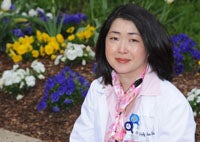The Perfect Storm of Allergies

Posted in GUMC Stories
 An expectant mother does everything she can to ensure the health of her unborn baby. She will eat a healthy balanced diet, exercise, and stops using medications that could harm the baby. Later, she breast feeds to provide the benefits of breast milk. However a few years later, her child develops a severe peanut allergy ⎯ and a tiny exposure could cause a potentially fatal anaphylactic shock.
An expectant mother does everything she can to ensure the health of her unborn baby. She will eat a healthy balanced diet, exercise, and stops using medications that could harm the baby. Later, she breast feeds to provide the benefits of breast milk. However a few years later, her child develops a severe peanut allergy ⎯ and a tiny exposure could cause a potentially fatal anaphylactic shock.
It’s a story Sally Joo Bailey, M.D., has heard countless times. “My patients always want to know how their child ended up with a food allergy when no one in the family has food allergies,” says this allergist, an assistant professor in the department of pediatrics at Georgetown University Medical Center (GUMC).
“Parents are always shocked to learn about the perfect storm of an allergy. That occurs when one or both parents may have nasal allergies and pass on their genetic tendency to develop atopy (allergies) to their baby. Then, if the mother eats highly allergenic foods (peanuts, tree nuts, fish, shellfish) later in pregnancy or during breast-feeding, the child has become exposed to these highly allergic foods.
“One inherits the genetic tendency for allergies but it’s the environmental exposure which then creates the right setting ⎯ the perfect storm ⎯ for developing allergies, whether it’s an allergy to a food or the environment,” she says. Without the exposure the allergy would not develop.
But it took a lot of innovative research to come up with the answer.
Dad is allergic to cat; son is allergic to peanuts
As a medical resident in pediatrics at Georgetown University School of Medicine from 1998-2001, Bailey learned about the relationship between asthma and allergies ⎯that there is a three-fold higher risk for a person with allergies to develop asthma, compared to individuals without allergies. During her fellowship training in both adult and pediatric allergy at The Johns Hopkins Hospital, she was actively involved in the research of asthma, allergies, and food allergies. There she developed a special interest in food allergies while working with Robert Wood, M.D., a world expert on peanut allergy. Later, after restarting the allergy division at Weil Cornell Medical Center/New York Presbyterian Hospital, Bailey returned to GUMC in 2006 to work with Howard Pung, M.D., the chief of the allergy and immunology division.
 Bailey says that up to 8 percent of children in the U. S. develop food allergies, and that there are approximately 150 deaths per year from a severe allergic reaction to such foods as milk, eggs, peanuts, tree nuts, seeds, fish and shellfish.
Bailey says that up to 8 percent of children in the U. S. develop food allergies, and that there are approximately 150 deaths per year from a severe allergic reaction to such foods as milk, eggs, peanuts, tree nuts, seeds, fish and shellfish.
But the question she has been most interested in is “how to identify those at highest risk so that we can hopefully prevent the development of food allergies. Most parents with a history of food allergies are warned by their physicians about the risk of their unborn child developing food allergies. However that does not seem to capture the majority of children being born with food allergies,” she says. “Just because a Dad is allergic to a cat doesn’t mean his child will be allergic to a cat.–it may be to peanuts.”
So Bailey and Sonya Chawla, M.D., a chief medical resident in internal medicine at MedStar Georgetown University Hospital, looked at data to try to tease out the risk factors associated with development of food allergies. Their goal is to inform physicians such as obstetricians, family practitioners, pediatricians, and parents-to-be about these risk factors.
They found that only about 3 percent of the children with food allergies had a parental history of food allergies, however approximately 80 percent had a parent with allergic rhinitis (environmental allergy).
Their preliminary data received a lot of national interest when it was presented at the top national allergy conference in 2009. So they decided to gather more data “in order to answer some of the questions that other allergists nationally and internationally were asking in regards to risk factors for developing food allergies.” That effort is ongoing.
Some food allergens can be outgrown
Bailey says it’s important for parents to understand that the risk of allergies goes beyond the individual who has allergies and can reach even into the womb. “Exposing a developing baby or a suckling infant who has a genetic tendency to allergies to foods known to provoke allergies is enough to foster a food allergy in the child,” she says.
That means that a mother should be cautious and avoid peanuts, tree nuts, or seafood in the third trimester and especially while breast-feeding; other allergenic foods such as milk, eggs, wheat, and soy can be eaten in small quantities as they constitute a well rounded diet, and the majority of infants who do develop allergies to these foods tend to outgrow them. “On the other hand, only 10-20 percent of children who develop an allergy to peanuts, tree nuts, and seafood outgrow them,” she says. A child at risk should avoid these highly allergenic foods until they are three years old, Bailey adds.
When she was pregnant in 2004, Bailey suspected this association between environmental and food allergies. And while her daughter does not currently have any food allergies, she did have a mild egg allergy, which she quickly outgrew with strict avoidance of eggs in her diet. She currently has environmental allergies to cats ⎯ like her mother ⎯ as well as mild asthma.
“Genetics gives you the blueprint, however nature and environmental exposure contributes to the rest,” Bailey says. “Our job, as parents, is to protect our children, which in this case means knowing as a parent that if you have environmental allergies, then your child may be at risk of developing food allergies.
“With this new information, hopefully you can prevent and protect your children from developing severe anaphylactic food allergies and thus avoid, that perfect allergenic storm.”
By Renee Twombly, GUMC Communications
(Published April 12, 2012)
